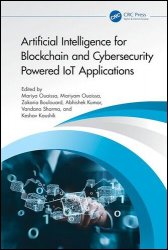Artificial Intelligence for Blockchain and Cybersecurity Powered IoT Applications
- Добавил: literator
- Дата: 12-11-2024, 17:43
- Комментариев: 0
 Название: Artificial Intelligence for Blockchain and Cybersecurity Powered IoT Applications
Название: Artificial Intelligence for Blockchain and Cybersecurity Powered IoT ApplicationsАвтор: Mariya Ouaissa, Mariyam Ouaissa, Zakaria Boulouard, Abhishek Kumar, Vandana Sharma, Keshav Kaushik
Издательство: CRC Press
Год: 2025
Страниц: 289
Язык: английский
Формат: pdf (true), epub
Размер: 28.3 MB
The objective of this book is to showcase recent solutions and discuss the opportunities that AI, blockchain, and even their combinations can present to solve the issue of Internet of Things (IoT) security. It delves into cuttingedge technologies and methodologies, illustrating how these innovations can fortify IoT ecosystems against security threats. The discussion includes a comprehensive analysis of AI techniques such as machine learning and deep learning, which can detect and respond to security breaches in real time. The role of blockchain in ensuring data integrity, transparency, and tamper- proof transactions is also thoroughly examined. Furthermore, this book will present solutions that will help analyze complex patterns in user data and ultimately improve productivity.
In an increasingly interconnected world, where digital technologies permeate every aspect of our lives, cybersecurity has emerged as a critical concern. With the proliferation of cyber threats ranging from data breaches and ransomware attacks to sophisticated state-sponsored espionage, safeguarding sensitive information and ensuring the integrity of digital systems have become paramount. Traditional approaches to cybersecurity, such as firewalls and antivirus software, are no longer sufficient to combat the evolving tactics of cybercriminals and malicious actors.
In this context, the role of foundational models in cybersecurity has garnered significant attention. These models provide the theoretical underpinnings and methodological frameworks necessary for understanding, analyzing, and mitigating cyber threats. From rule-based systems that enforce predefined security policies to advanced machine learning algorithms capable of detecting anomalous behavior, foundational models form the backbone of modern cybersecurity defenses.
However, as the cyber threat landscape continues to evolve with the emergence of new attack vectors and sophisticated adversaries, there is a pressing need to reassess and enhance existing foundational models. Moreover, the advent of artificial intelligence and natural language processing has opened up new possibilities for bolstering cybersecurity capabilities through the integration of language models and advanced analytics techniques.
Foundation models have primarily been developed in the field of natural language processing (NLP), which is where our focus lies for now. However, similar to how deep learning first gained traction in computer vision but later expanded beyond it, we view foundation models as a broader AI paradigm, not confined exclusively to NLP. Foundation models are a class of machine learning models characterized by their extensive training on broad datasets, often using self-supervised learning techniques. These models are designed to be adaptable to a wide range of downstream tasks. Examples include Bidirectional Encoder Representations from Transformers (BERT), Generative Pre-Trained Transformer 3 (GPT-3), and Contrastive Language-Image Pre-Training (CLIP). The term “foundation models” underscores their central yet incomplete nature, indicating that while they provide a robust starting point, they require further fine-tuning or adaptation to specific applications. The models are built using standard deep learning and transfer learning approaches but at a scale that brings forth new emergent capabilities.
Скачать Artificial Intelligence for Blockchain and Cybersecurity Powered IoT Applications
[related-news] [/related-news]
Внимание
Уважаемый посетитель, Вы зашли на сайт как незарегистрированный пользователь.
Мы рекомендуем Вам зарегистрироваться либо войти на сайт под своим именем.
Уважаемый посетитель, Вы зашли на сайт как незарегистрированный пользователь.
Мы рекомендуем Вам зарегистрироваться либо войти на сайт под своим именем.
